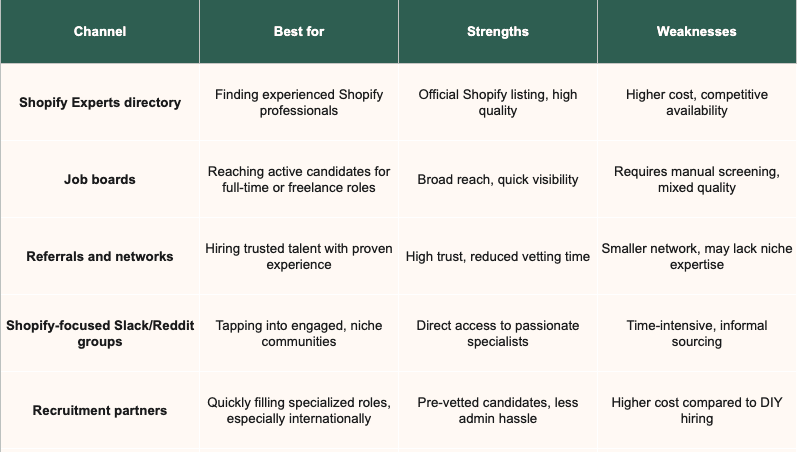Key Takeaways
- To hire a Shopify developer, you have three main sourcing options: local candidates, remote workers within the US, or international talent from regions like Latin America. You can find candidates through job boards, the Shopify Experts directory, referrals, or recruitment partners.
- Shopify developer salaries range from $75,000–$145,000 annually in the US, while Latin American developers with equivalent skills typically earn $30,000–$66,000 per year. This significant cost difference reflects local living expenses rather than skill level, allowing companies to hire senior-level talent at mid-level US budgets.
- Essential skills for Shopify developers include Liquid templating, JavaScript proficiency, theme customization abilities, and performance optimization knowledge. Equally important are soft skills like clear communication, proactive problem-solving, and the ability to collaborate with non-technical team members, as these determine long-term success beyond just technical capability.
Shopify might make it easy to launch an online store, but finding a developer who can truly make it perform is a different story. Great Shopify developers don’t just tweak themes or install apps. They build fast, stable, conversion-ready storefronts that help your business grow.
If you’re looking for practical guidance on how to hire Shopify developers who can deliver real results, this guide will walk you through the entire process. Whether you plan to hire in-house, work with someone remotely in the US, or expand your search internationally, the fundamentals stay the same.
We’ll cover what Shopify developers do, their salary expectations, and what skills matter most. You’ll also learn where to find the right candidates, how to evaluate them effectively, and common mistakes to avoid so you can hire with confidence.
What Does a Shopify Developer Do?
Shopify developers build, customize, and maintain e-commerce storefronts that convert visitors into paying customers.
A Shopify developer works with Shopify’s core tech stack. They use Liquid for templating, Ruby for back-end functionality, and JavaScript, HTML, and CSS for the front-end. Many are also familiar with Hydrogen, Shopify’s React-based framework for building custom storefronts.
Their typical tasks include developing themes, integrating apps, improving performance, and supporting advanced features like Shopify Plus, which is why they’re often miscategorized as full-stack developers.
While they do cover both front-end and back-end tasks, they don’t manage databases or infrastructure beyond what Shopify already provides.
How Much Does It Cost to Hire a Shopify Developer?
Salaries for Shopify developers can vary significantly depending on experience, location, and project scope. In the US, hiring a full-time developer typically means budgeting for a high salary.
Here’s what US-based Shopify developers typically earn:
- Junior: $75,000 – $95,000 per year
- Mid-level: $95,000 – $130,000 per year
- Senior: $130,000 – $145,000 per year
These ranges can shift depending on the complexity of the role. Developers who specialize in custom Shopify apps, integrations with third-party systems, or enterprise-level Shopify Plus features tend to fall on the higher end of the salary range.
If cost is a concern, companies open to hiring internationally can benefit from significant savings without sacrificing skill and quality.
Nearshore hiring (hiring from nearby countries) in Latin America is one of those options.
In our experience, typical salary ranges in Latin America are:
- Junior Shopify Developer: $30,000 – $42,000 per year
- Mid-level Shopify Developer: $42,000 – $54,000 per year
- Senior Shopify Developer: $54,000 – $66,000 per year
That translates to cost savings of around 58%–60%, depending on the role. For many companies, this allows for either hiring senior-level developers at a mid-level US salary or building out a stronger, more scalable team within the same budget.
The lower cost reflects a difference in living expenses, not in professionalism or expertise.
So if you’re trying to decide how much to budget for hiring a Shopify developer, the answer depends on where you will look (which we’ll cover a bit more further on). Some flexibility in location often leads to more sustainable hiring decisions, especially when weighing up whether to hire developers locally or offshore.

What Skills Should You Look For When Hiring a Shopify Developer?
Shopify developers have different skill sets. Some can modify a theme or install apps, but others can build entirely custom storefronts from the ground up. Knowing what to look for can make the difference between hiring someone who just keeps the lights on and someone who actually helps your business grow.
Hard skills (the must-haves)
Shopify developers need to have these technical skills:
- Liquid templating language: Liquid is the backbone of every Shopify theme, but it’s not exclusive to Shopify. It also powers several popular web platforms like Zendesk, Thinkific, Spiceworks, and 500px. That’s why it’s important to confirm your candidate has direct experience using Liquid within Shopify’s environment and not just familiarity with the syntax.
- JavaScript and modern JS frameworks: JavaScript is essential for dynamic storefront elements like interactive carts, modals, and animations. Developers should also have experience with modern frameworks like React, especially if you plan to use Hydrogen for custom builds. Ask to see GitHub examples or walk through recent front-end work in an interview.
- Theme customization and Shopify APIs: From simple layout tweaks to more complex structural changes, developers should be comfortable editing themes directly or using Shopify’s CLI. They should also know how to connect your store to other tools or services using Shopify’s REST or GraphQL APIs.
- Performance tuning and SEO fundamentals: Most users will abandon a website after only 4 seconds of wait time, which means that slow sites lose sales. Look for candidates who know how to reduce render-blocking scripts, compress assets, and structure pages for faster loading. Basic SEO knowledge, like schema markup, title tags, and clean URL structures, should also be part of their skill set.
- Understanding of payment systems and storefront UX: Great Shopify developers consider the full customer journey. That means optimizing checkout flows, troubleshooting abandoned cart issues, and making sure that payment integrations function smoothly. If they can reference UX best practices that impact conversion, even better.
Soft skills (equally important)
While technical skills get your store running, soft skills keep projects moving forward:
- Clear, structured communication: Many Shopify developers work asynchronously, especially in distributed teams. Clear documentation, regular updates, and well-written Slack messages can prevent confusion and missed deadlines.
- Proactive problem solving: The best devs don’t wait for instructions. They anticipate issues and suggest improvements. Ask about a time they solved a technical problem without being asked, especially one that impacted the business.
- Ability to explain technical concepts to non-devs: Shopify developers often collaborate with marketers, designers, and founders. Look for people who can explain their decisions in plain language, not just dev jargon.
- Taking ownership over deliverables: In our experience, top developers are accountable. They care about outcomes, not just checking off tickets. During interviews, ask how they handle missed deadlines or unexpected bugs.
- Collaboration with designers and back-end engineers: Shopify is rarely developed and run by a single person. Developers should know how to work with Figma files, align on API expectations, and flag issues early to avoid blockers. Good candidates will share examples of successful cross-functional work.
The “nice-to-have” skills (the differentiators)
These skills aren’t essential but can give your hire a strategic edge. This is especially true if you’re scaling quickly:
- Experience with Shopify Plus: Handling multi-store setups, advanced automation, and larger-scale deployments requires experience beyond the standard Shopify toolkit.
- A/B testing and CRO experience: Developers who understand conversion rate optimization can help improve performance across key funnels, often with small, high-impact changes.
- Headless commerce or Hydrogen familiarity: Headless builds are gaining traction. Developers who know Shopify’s Hydrogen or other React-based frameworks can help you future-proof your store.
- Shopify app development: If you plan to build custom features or sell apps in the Shopify App Store, experience in app development is a major plus.
- Agile or sprint-based team experience: Shopify developers who’ve worked in structured teams are often better at estimating work, managing scope, and delivering on time.
Where Can You Find and Hire Great Shopify Developers?
Hiring a Shopify developer starts with two decisions:
- Where to hire from (local, US-remote, international)
- How to reach the right candidates in that location
Whether you’re looking for someone to join your in-office team or considering international options, making the right choices will save you time and help you land stronger talent.
Choosing the right location
Start by deciding if your Shopify developer will work in-office, remotely within the US, or remotely from another country.
Each option has its own trade-offs in terms of cost, availability, and collaboration:
- Local/in-office developers: Hiring someone local can make collaboration easier, especially for teams that rely on in-person meetings or close coordination with other departments. There are fewer barriers to onboarding and admin tasks, and the developer can be deeply embedded in your company culture. However, this option often comes with the highest price tag, especially in major US cities.
- Remote US-based developers: Remote hiring within the US gives you access to a wider talent pool while maintaining cultural familiarity and business alignment. Developers are used to US workflows and communication styles, and time zone differences are minimal. However, compensation expectations remain at US salary levels.
- International developers: If you’re open to hiring internationally, the talent pool becomes much larger and often more affordable. Developers in regions like Latin America, Eastern Europe, and South and Southeast Asia bring strong technical skills and experience, often at significantly lower costs.
From our experience, Latin America is a particularly strong fit for US-based companies. Developers in this region offer a compelling mix of skills, communication ability, and working hour overlap.
These are just some of the benefits of working with offshore Shopify developers in Latin America:
- Time zone alignment: Most Latin American countries share similar working hours with US teams, making real-time collaboration and faster turnaround much easier.
- Strong English proficiency: It’s relatively easy to find developers fluent in English, which reduces miscommunication and helps projects move forward without friction.
- Cultural familiarity: LatAm developers often understand US business expectations, work culture, and e-commerce trends, making integration into your existing workflows smooth.
- Cost efficiency: Due to lower living costs, you can hire highly skilled professionals at a more sustainable rate without compromising on quality.
That said, countries like the Philippines, India, and Poland also offer excellent Shopify talent. Just be aware of time zones and workflow differences when planning team integration.
Choosing the right sourcing channel
Once you’ve decided where to hire from, the next step is figuring out how to find qualified candidates. Here’s how different sourcing options stack up:

Each approach works best in different scenarios. If you need speed and can dedicate time to vetting, job boards or direct outreach may be enough.
The right approach often depends on your priorities. For some teams, combining multiple sourcing methods, such as using internal referrals, posting in Shopify forums, and advertising on job boards, can yield good results.
If you’re hiring for a long-term role or working internationally, using a recruitment partner can help shorten your time and reduce the risk of a bad match. We’ll dig into the specific benefits of that approach later on, but it’s particularly useful for sourcing international talent.
To get an idea of the companies you could consider working with, see our article on 11 companies to consider for hiring developers in Latin America.
Of course, hiring isn’t your only option. Some companies prefer to work with Shopify development outsourcing companies for specific projects or when they need specialized expertise without adding to their permanent headcount. This approach works particularly well for one-off builds, major migrations, or complex integrations.
How to Hire the Best Shopify Developers: Best Practices
Hiring a Shopify developer is one thing. Hiring one who understands your goals, integrates well with your team, and builds solutions that grow with your business takes structure. A few thoughtful steps early on can save weeks of back-and-forth and help you hire faster, with better results.
Here’s how smart hiring teams approach the process from start to finish.
Stage 1: Set yourself up for success before sourcing
Know what you actually need and not what sounds impressive
Every business wants a developer who can “do it all,” but clarity is more valuable than ambition. Do you need someone who can customize existing themes or someone who can build custom Shopify apps from scratch? Is this a short-term project or a long-term technical partner? The answers should shape everything from your interview questions to your offer.
Think about your current stack and what’s coming. Will you eventually need support for Hydrogen or Shopify Plus? That context will help you prioritize skills that matter now and set realistic expectations for growth.
Create a job description that attracts the right candidates
Top candidates are busy, so a clear, focused job description helps them quickly understand the role and decide if they’re a fit. Be upfront about technical requirements, team structure, and business goals. If you’re hiring remotely, include time zone expectations, communication tools, and work hours.
According to a WeAreDevelopers survey, developers value cross-team collaboration. If your company encourages developers to work alongside design, marketing, or product, and not just within isolated dev teams, say so. You’re more likely to attract forward-thinking candidates who want to contribute beyond just code.
If you’re writing your job post from scratch, we also recommend checking out our guide on how to write a great developer job description that actually attracts qualified candidates.
Stage 2: Screen for skill, strategy, and ownership
Give candidates a real-world test and review it together
Portfolios can show potential, but hands-on work reveals how someone solves problems in practice. Assign a small, paid task such as refactoring a Shopify theme file, identifying performance issues, or building a basic feature using Liquid and JavaScript.
Our recruiters recommend either a take-home or a live test. What matters most is reviewing the results with the candidate. Ask them to walk through their decisions. Can they explain trade-offs and justify their approach? You’re not just looking for technical skills, but also evaluating how they think.
Look for business context and ownership
Strong Shopify developers understand both the technical problem and the business goal behind it. Ask candidates to describe a past project. What was the challenge? What did they contribute? If they can’t explain their role clearly, that’s a concern.
Follow up with questions about how they respond to feedback or shifting priorities. Developers who take initiative and adjust their approach when needed are more likely to succeed in fast-moving environments.
Watch for early red flags
Some signals are easy to overlook but important to catch. Vague answers about past projects. Evasive responses when asked about mistakes. Blaming others for things that went wrong. These patterns can suggest a lack of experience or accountability.
Pay close attention to how candidates talk about their work. Tools are easy to list. True value shows up in how they describe problems, decisions, and outcomes.
Stage 3: Make the offer and close the deal
Move quickly and be transparent
Top developers don’t sit on the market for long. If someone fits your needs, don’t drag out the process. Set expectations about your timeline from the beginning, and when you’re ready to make an offer, do it confidently.
Offer more than a paycheck
In our experience, developers care about three things beyond salary: the freedom to do meaningful work, time to rest, and opportunities to grow. That means offering flexibility, PTO that reflects local standards, and clear communication about their role in the bigger picture.
If you’re hiring a remote Shopify developer, the benefits you offer matter even more. Think about what makes the role practical and appealing from the start. This might include:
- Monthly stipends for internet or coworking spaces.
- Shipping out high-quality equipment to set them up for success.
- Flexible hours based on output, not a fixed 9-to-5.
- Clear documentation and onboarding support so they aren’t left guessing.
These show that your company respects how remote developers work best. If you want to attract serious candidates, include these details in your remote worker job description from day one.
You can also explore what makes a competitive offer in our full guide on making a good job offer to hire and retain top talent.

Top Interview Questions for Hiring Shopify Developers That Reveal the Right Fit
Interviewing Shopify developers isn’t just about checking their GitHub or asking which frameworks they use. You need to understand how they think, how they work with others, and whether they can consistently deliver clean, scalable solutions under real business conditions.
Below are five questions to ask and what each one uncovers about your potential Shopify developer.
“Can you walk me through a recent Shopify project and your specific role in it?”
This question tests for clarity, ownership, and real experience.
You’re looking for a candidate who can explain the business goal, their technical contributions, and the impact their work had. A strong answer might touch on theme customization, performance improvements, or collaboration with marketing or design.
Red flag: Vague or overly general answers or someone who can’t explain what they personally contributed.
“What’s your process for improving site speed on a Shopify storefront?”
Speed affects sales, so this question checks their performance mindset.
Good developers will mention techniques like lazy loading, minifying assets, analyzing performance with tools like Lighthouse, and reducing unused code. An added plus if they reference the impact of these optimizations on conversion rates.
Red flag: Focusing only on superficial changes like “removing images” without understanding deeper performance fixes.
“How do you typically work with designers or marketing teams when requirements shift?”
Shopify developers rarely work in isolation. This question helps gauge flexibility and communication.
Strong candidates will talk about aligning timelines, managing feedback loops, and adjusting code without compromising quality.
Red flag: Blaming scope creep or avoiding shared accountability when describing past collaborations.
“Have you worked with Shopify Plus or headless builds like Hydrogen? What was the most challenging part?”
This tests for depth of experience, especially with more complex builds.
Look for someone who can explain the technical differences, describe integrations or deployment workflows, and reflect on how they overcame specific hurdles.
Red flag: Overstating familiarity or glossing over technical challenges they should have encountered.
“How do you handle feedback on your code or implementation decisions?”
This question reveals emotional maturity and a growth mindset.
Strong candidates won’t just say they “accept feedback.” They’ll explain how they’ve applied it, improved from it, and handled disagreements constructively.
Red flag: Defensiveness, or someone who struggles to recall a specific moment when feedback improved their work.
These interview questions for hiring Shopify developers are designed to help you uncover who’s ready to build, scale, and collaborate.

Common Mistakes to Avoid When Hiring A Shopify Developer
Even with a strong hiring process, it’s easy to fall into traps that slow you down. These mistakes can even lead to the wrong hire altogether. Here are five common mistakes we’ve seen and how to avoid them.
1. Prioritizing cost over quality
Shopify development is technical work, but it’s also your revenue engine. If you hire based on price alone, you risk launching a store that looks fine on the surface but breaks under traffic or doesn’t convert.
A cheaper junior developer might save money upfront, but experienced developers deliver better long-term value. They write cleaner code, anticipate performance issues, and understand how technical decisions impact conversion rates.
They also work faster and require less hand-holding, which means projects get done right the first time.
For example, an experienced developer might charge more per hour but complete a complex theme customization in half the time it takes someone junior. They’ll also build it to handle traffic spikes and future feature additions without requiring a complete rebuild.
When your store is your primary revenue source, investing in quality development pays for itself through better performance and fewer headaches down the road.
2. Filtering candidates based on degrees
In some regions, like Latin America, many great developers start working before finishing a formal degree. Dismissing candidates without a college background can cause you to overlook some of the most capable talent available.
What matters more is experience: Have they built and maintained Shopify stores? Can they show measurable results? Focus on real-world projects, communication skills, and the ability to write clean, scalable code.
3. Overcomplicating the hiring process
Lengthy hiring funnels with multiple technical rounds or slow decision-making can put off top candidates. Shopify developers are in high demand, and many won’t stick around if they don’t hear back promptly or are asked to complete unpaid assignments.
If your hiring process takes more than a week or two from the first conversation to offer, you’re likely losing out. Use a short, focused test and a couple of well-structured interviews. Most importantly, always keep candidates updated.
4. Not being upfront about your tech roadmap
Some teams hire developers for today’s stack, only to realize that three months later, they need to switch to Hydrogen or Shopify Plus. This mismatch leads to friction, rework, or even turnover.
Be clear from the start about where your platform is going. If you’re planning to integrate headless builds or custom Shopify apps, share that during the interview. Great developers want to know what’s ahead. This is so they can decide if they’re a fit for you.
5. Relying only on portfolios to assess skill
A polished GitHub repo or theme demo can look impressive, but it doesn’t show how the developer works in context. Portfolios are curated and don’t reflect real-world work.
You don’t know how much support they had, how long the work took, or whether they even wrote the code themselves.
Always go beyond the portfolio. Use a paid, real-world test to see how they approach your specific challenges. Combine that with interviews that focus on communication, problem-solving, and accountability.
Why Working With a Recruiting Partner Makes a Difference
Hiring a Shopify developer on your own can work. This is especially true if you have time, a strong process, and experience hiring for technical roles. However, for many businesses, that’s not always the case.
If you’re short on time, hiring internationally, or struggling to find someone with the right mix of technical skills and business awareness, working with a recruiting partner can save time and reduce hiring issues.
Partners who specialize in Shopify roles can help you:
- Shorten your time-to-hire by handling sourcing and screening
- Identify better-fit candidates aligned with your goals
- Manage international logistics like contracts and compliance
Recruitment partners are especially helpful when hiring outside the US, as coordinating across time zones and handling local requirements can slow you down without the right support.
If you’re exploring international hiring options, you can solve many recruitment hurdles with LatAm talent. In our experience, this is one of the best ways to access experienced Shopify developers who align with US work hours and expectations.
Final Thoughts
The right Shopify developer can do more than just build your store.
They can write clean, scalable code that aligns with product goals and help you move faster without sacrificing quality. Getting that hire right means knowing what you need, evaluating thoroughly, and acting decisively when the fit is clear.
Hiring pre-vetted Shopify developers who understand your stack, your customers, and your pace can save time and deliver better results, especially when you need someone who can contribute right away.
If working with a recruitment partner seems like the right next step, consider a firm that specializes in making hiring simple and effective.
At Near, we connect businesses with pre-vetted Shopify developers in Latin America who share your time zone, communicate clearly, and bring proven experience at a more sustainable cost than hiring in the US.
Want to explore your options? Let’s talk. Book a free consultation.













.png)






%20(1).png)
%20(1).png)
